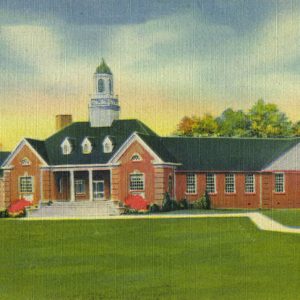calsfoundation@cals.org
Thomas C. McRae Memorial Sanatorium
aka: Alexander Human Development Center
The Thomas C. McRae Memorial Sanatorium in Alexander (Pulaski and Saline counties) was established in 1931, in the midst of the Jim Crow era of racial segregation, to treat African-American victims of tuberculosis (often called “consumption” at the time). It was the first facility of its kind in Arkansas. It was opened twenty-two years after the Arkansas State Tuberculosis Sanatorium in Booneville (Logan County), which treated only white patients. In 1968, following the integration of the state’s sanatoriums, the Alexander site became the Alexander Human Development Center. In 2011, the facility was closed.
The bill that created the McRae Sanatorium was introduced in the Arkansas General Assembly in 1923. It had strong support from the Arkansas Tuberculosis Association, particularly from its executive secretary, Erle Chambers. Governor Thomas C. McRae was president of the association after leaving office in 1925. Because he championed the cause, the sanatorium at Alexander bore his name. In 1924, a tract of land was chosen in Alexander because it was “near the center of Negro population” and close to Little Rock (Pulaski County), which had additional medical facilities, including what is now the University of Arkansas for Medical Sciences (UAMS).
The sanatorium’s first superintendent (and only doctor) was Dr. Hugh A. Browne, a 1928 graduate of Howard University’s Medical Department. Knowing that few African-American doctors lived in Arkansas, Dr. Browne took an eighty-seven-percent pay cut (from $1,500 to $200 a month) to move to Arkansas to oversee the McRae Sanatorium. He had been working at the Wheatley-Provident Hospital in Kansas City, Missouri, which was a hospital for black patients that also trained black physicians. At the time of the McRae Sanatorium’s opening, Browne and his two nurses were charged with treating all consumptive black Arkansans.
Facilities for black Arkansans were not given priority when it came to the allowance of state funds. When it opened in 1931, the McRae Sanatorium had only twenty-six beds; in 1933, ten more were added after an expansion was approved by the state legislature. (As a point of comparison, the sanatorium at Booneville, at its opening in 1909, had 500 beds.) In 1935, there were 160 people on McRae’s waiting list. Another expansion was approved in 1938, which paid for the creation of a dedicated patients’ building with facilities for 139 and a nurse’s home with a capacity of thirty-two. In addition, surgical facilities were added in the main building, including an operating room, dressing room, and sterilizing room. By 1945, the waiting list at the McRae Sanatorium had increased to over 600 for the 196-bed facility. In 1946, the state legislature appropriated money for a four-story infirmary building, but it was not opened for patients until September 1949. Ten years later, in 1959, the legislature had a children’s building built on site, but new advances in medicine and surgery had cut the number of patients by 150 by that time. The children’s building and an auxiliary nurse’s home were occupied by July 1, 1960.
Many programs were in operation at the McRae Sanatorium between its inception and its closure in 1968. In 1938, education courses for the staff were implemented, and rehabilitation classes were taught to patients. Nurse training courses began in 1940, and in 1947 two surplus army buildings were given to the facility to house cooking, cosmetology, sewing, and manual training classes. Those buildings were later converted into an auditorium, a library, two classrooms, a barbershop, a cosmetology room, and a homemaking class. Later additions included improvements to the education department and the addition of a staff counselor. There was also an in-house laboratory with an X-ray machine. Browne’s wife, Norma J. Browne, held many positions at McRae, including secretary to Browne, chief administrative assistant, purchasing agent, and personnel director.
Hugh A. Browne retired in 1962 after thirty-one years of service and returned to Kansas City, where he died on November 15 of that year. He was a member of the American College of Chest Physicians, the American Thoracic Society, and the National Medical Association. He had suffered a stroke three years prior to his retirement.
Arkansas’s two sanatoriums remained segregated until 1967. Federal integration policies caused the two to combine, and the McRae site became the Alexander Human Development Center, which opened its doors in 1968. In addition to tuberculosis treatments, the Alexander center offered occupational, physical, and speech therapy; psychological assessments; general medical care; and rehabilitation services.
Overseen by the Arkansas Department of Human Services, the Alexander center operated for forty-three years until allegations began to arise in the early 2000s of neglect and rape of patients, failed safety inspections, and a general refusal to adhere to federal guidelines. These infractions prompted investigations, and the Arkansas-Democrat Gazette announced on May 18, 2010, that Governor Mike Beebe planned to close the Alexander Human Development Center. At the time, at least 109 men were living there. The center closed in 2011. The abandoned facility later came under private ownership before being purchased by the Alexander Police Department in 2018. A major fire damaged the structure on March 18, 2020.
For additional information:
Browne, Hugh A. “A Brief History of McRae Memorial Sanatorium.” Journal of the National Medical Association 54 (July 1962): 517–519. Online at https://www.ncbi.nlm.nih.gov/pmc/articles/PMC2642290/ (accessed September 7, 2017).
“Dr. Hugh A. Browne.” Journal of the National Medical Association 55 (May 1963): 254.
Floyd, Larry C., and Joseph H. Bates. Stalking the Great Killer: Arkansas’s Long War on Tuberculosis. Norman: University of Oklahoma Press, 2023.
Gibbons, Shauna. “Creating the Thomas McRae Sanatorium for Negroes: Race, Contagion, and Space in Jim Crow Arkansas.” Ozark Historical Review 41 (2012): 1–22.
Cody Lynn Berry
University of Arkansas at Little Rock
 Early Twentieth Century, 1901 through 1940
Early Twentieth Century, 1901 through 1940 Health and Medicine
Health and Medicine Ish, George William Stanley
Ish, George William Stanley Thomas C. McRae Memorial Sanatorium
Thomas C. McRae Memorial Sanatorium 




The property was owned by the state until this year and deeded to the city. See article at link below: http://thealexandrian2013.blogspot.com/2018/02/alexander-council-approves-ordinance.html